英语基本句式小结
- 格式:pdf
- 大小:151.83 KB
- 文档页数:4
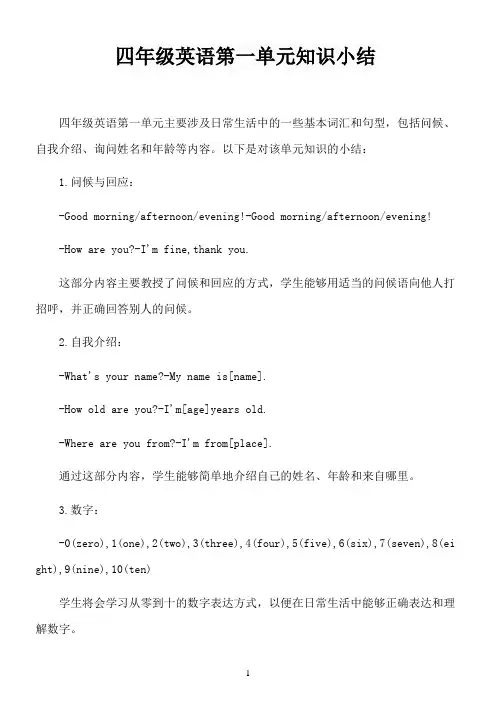
四年级英语第一单元知识小结四年级英语第一单元主要涉及日常生活中的一些基本词汇和句型,包括问候、自我介绍、询问姓名和年龄等内容。
以下是对该单元知识的小结:1.问候与回应:-Good morning/afternoon/evening!-Good morning/afternoon/evening!-How are you?-I'm fine,thank you.这部分内容主要教授了问候和回应的方式,学生能够用适当的问候语向他人打招呼,并正确回答别人的问候。
2.自我介绍:-What's your name?-My name is[name].-How old are you?-I'm[age]years old.-Where are you from?-I'm from[place].通过这部分内容,学生能够简单地介绍自己的姓名、年龄和来自哪里。
3.数字:-0(zero),1(one),2(two),3(three),4(four),5(five),6(six),7(seven),8(ei ght),9(nine),10(ten)学生将会学习从零到十的数字表达方式,以便在日常生活中能够正确表达和理解数字。
4.课堂用语:-Open your book,please.-Close your book,please.-Listen carefully.-Stand up/Sit down.-Repeat after me.-Good job/Well done.这部分内容主要教授了课堂常用的指令和鼓励用语,学生能够理解老师的指示并正确执行。
5.日常用语:-What's this?-It's a[object].-Can I have...?-Yes,you can./No,you can't.-Thank you.-You're welcome.通过这部分内容,学生能够询问物品的名称,并学会礼貌地请求和感谢别人。
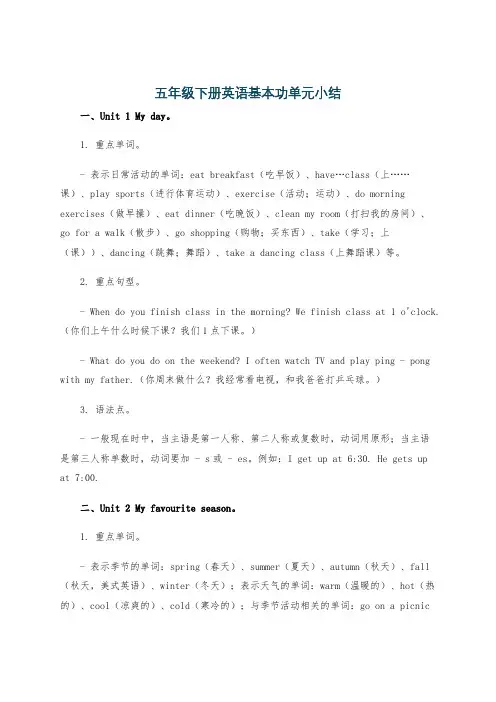
五年级下册英语基本功单元小结一、Unit 1 My day。
1. 重点单词。
- 表示日常活动的单词:eat breakfast(吃早饭)、have…class(上……课)、play sports(进行体育运动)、exercise(活动;运动)、do morning exercises(做早操)、eat dinner(吃晚饭)、clean my room(打扫我的房间)、go for a walk(散步)、go shopping(购物;买东西)、take(学习;上(课))、dancing(跳舞;舞蹈)、take a dancing class(上舞蹈课)等。
2. 重点句型。
- When do you finish class in the morning? We finish class at 1 o'clock.(你们上午什么时候下课?我们1点下课。
)- What do you do on the weekend? I often watch TV and play ping - pong with my father.(你周末做什么?我经常看电视,和我爸爸打乒乓球。
)3. 语法点。
- 一般现在时中,当主语是第一人称、第二人称或复数时,动词用原形;当主语是第三人称单数时,动词要加 - s或 - es。
例如:I get up at 6:30. He gets up at 7:00.二、Unit 2 My favourite season。
1. 重点单词。
- 表示季节的单词:spring(春天)、summer(夏天)、autumn(秋天)、fall (秋天,美式英语)、winter(冬天);表示天气的单词:warm(温暖的)、hot(热的)、cool(凉爽的)、cold(寒冷的);与季节活动相关的单词:go on a picnic(去野餐)、pick apples(摘苹果)、make a snowman(堆雪人)、go swimming (去游泳)等。

Writing Techniques: 段落的连贯性:(1)总结、归纳类in a wordto some extent to sum up obviouslyon the whole in shortin a wayto concludeundoubtedlyin my viewin briefas a general rulethereforegenerally speakingin summery(2)比较、对比类on the contrary similarlyon the other hand however otherwisewhereaslike (+n.)equally importantin the same wayneverthelessunlike (+n.)in (sharp) contrast(3)举例、列举类for examplefirst, second, thirdwhat is morefor one thing, for another in addition last but not leastas an illustrationto begin withmoreoverfirst of allfor instancebesidesfurthermore(what is) more importantin the first place, in thesecond place(4)原因、结果类because (of) due tothussince on account ofowing tothereforeasfor this reasonas a result (of)consequentlyhence(5)让步类althoughit is true that…but in spite ofyet even thoughafter alldespitehoweveradmittedlyneverthelessgranted thatstillabove all surely needless to say most important of all(what is) even worse(there is) no doubtof coursein fact(6)强调类anywayparticularlyindeedmore often than notactuallyespecially(7)引言段的开头A proverb says…Just as the saying goes…It is often said that…As we all know,…As is known to all,…It is well known that…A recent survey indica tes/shows…Many people often ask this question, “…”Various views exist as to whether we should…It goes without saying that…Over the years…(主句用现在完成时)When it comes to…,It is generally/universally accepted /recognized /considered that…(8)发展段的开头It can be easily proved that…It is true that…No one can deny that…but the problem is not so simple…We must realize that…Others may find this to be true, but I do not. I believe that…Recent development in…indicates…A brief glance at…reveals that…Another key as pect of…is that…In contrast to…In most cases, however, (we)…As stated above…As mentioned above…Usually,…but…It can be roughly estimated that…On (the) one hand,…(But) on the other hand,…As far as…is (are) concerned,…Furthermore,…/ Moreover,…/ Besides,…In addition,…Despite (these limitations),…/ In spite of…(9)结尾段的开头Consequently…In summary,…All in all,…Based on the above mentioned, it can be concluded that…As a final comment, I should say that…Finally,…Hence,…It seems to me that the only possibility to do(of)...would be...Obviously the result is depend on (4)Thus, this is the very reason why…。
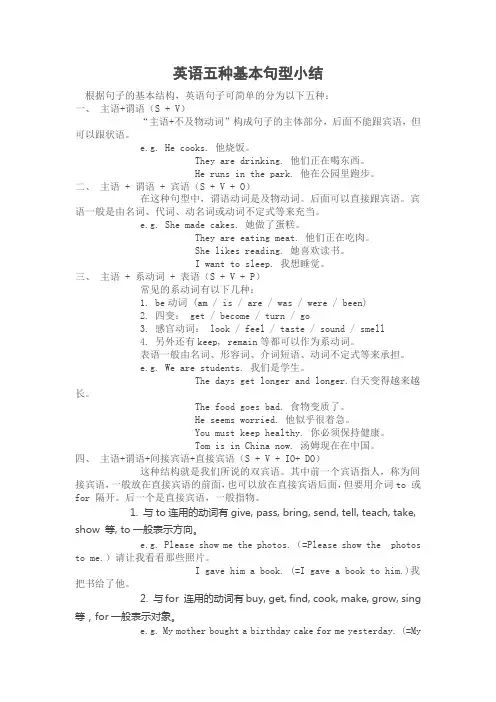
英语五种基本句型小结根据句子的基本结构,英语句子可简单的分为以下五种:一、主语+谓语(S + V)“主语+不及物动词”构成句子的主体部分,后面不能跟宾语,但可以跟状语。
e.g. He cooks. 他烧饭。
They are drinking. 他们正在喝东西。
He runs in the park. 他在公园里跑步。
二、主语 + 谓语 + 宾语(S + V + O)在这种句型中,谓语动词是及物动词。
后面可以直接跟宾语。
宾语一般是由名词、代词、动名词或动词不定式等来充当。
e.g. She made cakes. 她做了蛋糕。
They are eating meat. 他们正在吃肉。
She likes reading. 她喜欢读书。
I want to sleep. 我想睡觉。
三、主语 + 系动词 + 表语(S + V + P)常见的系动词有以下几种:1. be动词 (am / is / are / was / were / been)2. 四变: get / become / turn / go3. 感官动词: look / feel / taste / sound / smell4. 另外还有keep, remain等都可以作为系动词。
表语一般由名词、形容词、介词短语、动词不定式等来承担。
e.g. We are students. 我们是学生。
The days get longer and longer.白天变得越来越长。
The food goes bad. 食物变质了。
He seems worried. 他似乎很着急。
You must keep healthy. 你必须保持健康。
Tom is in China now. 汤姆现在在中国。
四、主语+谓语+间接宾语+直接宾语(S + V + IO+ DO)这种结构就是我们所说的双宾语。
其中前一个宾语指人,称为间接宾语,一般放在直接宾语的前面,也可以放在直接宾语后面,但要用介词to 或for 隔开。
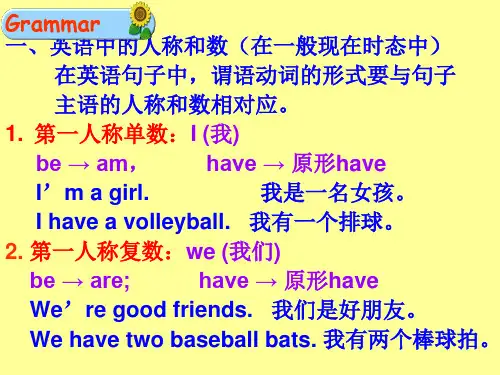
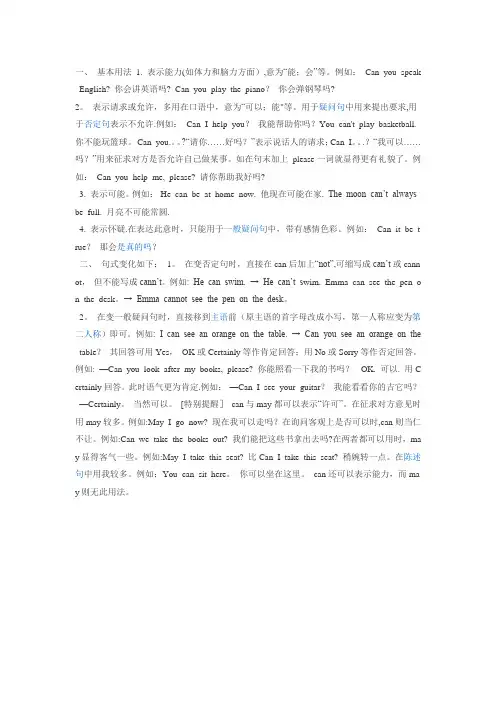
一、基本用法1. 表示能力(如体力和脑力方面),意为“能;会”等。
例如:Can you speak English? 你会讲英语吗? Can you play the piano?你会弹钢琴吗?2。
表示请求或允许,多用在口语中,意为“可以;能"等。
用于疑问句中用来提出要求,用于否定句表示不允许.例如:Can I help you?我能帮助你吗?You can't play basketball. 你不能玩篮球。
Can you.。
?“请你……好吗?”表示说话人的请求;Can I。
.?“我可以……吗?”用来征求对方是否允许自己做某事。
如在句末加上please一词就显得更有礼貌了。
例如:Can you help me, please? 请你帮助我好吗?3. 表示可能。
例如:He can be at home now. 他现在可能在家. The moon can’t always be full. 月亮不可能常圆.4. 表示怀疑.在表达此意时,只能用于一般疑问句中,带有感情色彩。
例如:Can it be t rue?那会是真的吗?二、句式变化如下:1。
在变否定句时,直接在can后加上“not”,可缩写成can’t或cann ot,但不能写成cann’t。
例如: He can swim. → He can’t s wim. Emma can see the pen o n the desk。
→ Emma cannot see the pen on the desk。
2。
在变一般疑问句时,直接移到主语前(原主语的首字母改成小写,第一人称应变为第二人称)即可。
例如: I can see an orange on the table. → Can you see an orange on the table?其回答可用Yes,OK或Certainly等作肯定回答;用No或Sorry等作否定回答。
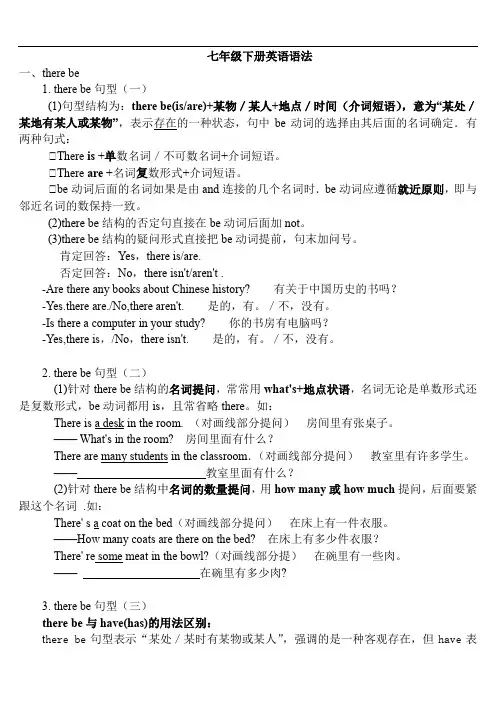
七年级下册英语语法一、there be1. there be句型(一)(1)句型结构为:there be(is/are)+某物/某人+地点/时间(介词短语),意为“某处/某地有某人或某物”,表示存在的一种状态,句中be动词的选择由其后面的名词确定.有两种句式:①There is +单数名词/不可数名词+介词短语。
①There are +名词复数形式+介词短语。
①be动词后面的名词如果是由and连接的几个名词时.be动词应遵循就近原则,即与邻近名词的数保持一致。
(2)there be结构的否定句直接在be动词后面加not。
(3)there be结构的疑问形式直接把be动词提前,句末加问号。
肯定回答:Yes,there is/are.否定回答:No,there isn't/aren't .-Are there any books about Chinese history? 有关于中国历史的书吗?-Yes.there are./No,there aren't. 是的,有。
/不,没有。
-Is there a computer in your study? 你的书房有电脑吗?-Yes,there is,/No,there isn't. 是的,有。
/不,没有。
2. there be句型(二)(1)针对there be结构的名词提问,常常用what's+地点状语,名词无论是单数形式还是复数形式,be动词都用is,且常省略there。
如:There is a desk in the room. (对画线部分提问)房间里有张桌子。
—— What's in the room? 房间里面有什么?There are many students in the classroom.(对画线部分提问)教室里有许多学生。
—— 教室里面有什么?(2)针对there be结构中名词的数量提问,用how many或how much提问,后面要紧跟这个名词.如:There' s a coat on the bed(对画线部分提问)在床上有一件衣服。
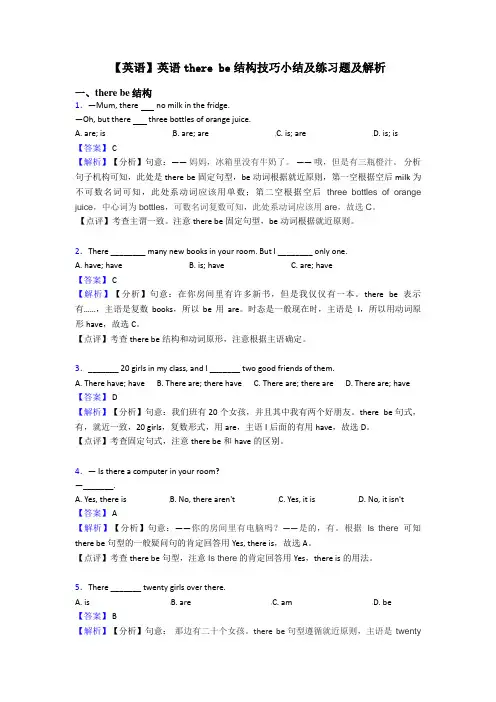
【英语】英语there be结构技巧小结及练习题及解析一、there be结构1.—Mum, there no milk in the fridge.—Oh, but there three bottles of orange juice.A. are; isB. are; areC. is; areD. is; is【答案】 C【解析】【分析】句意:——妈妈,冰箱里没有牛奶了。
——哦,但是有三瓶橙汁。
分析句子机构可知,此处是there be固定句型,be动词根据就近原则,第一空根据空后milk为不可数名词可知,此处系动词应该用单数;第二空根据空后three bottles of orange juice,中心词为bottles,可数名词复数可知,此处系动词应该用are,故选C。
【点评】考查主谓一致。
注意there be固定句型,be动词根据就近原则。
2.There ________ many new books in your room. But I ________ only one.A. have; haveB. is; haveC. are; have【答案】 C【解析】【分析】句意:在你房间里有许多新书,但是我仅仅有一本。
there be表示有……,主语是复数books,所以be用are。
时态是一般现在时,主语是I,所以用动词原形have,故选C。
【点评】考查there be结构和动词原形,注意根据主语确定。
3._______ 20 girls in my class, and I _______ two good friends of them.A. There have; haveB. There are; there haveC. There are; there areD. There are; have 【答案】 D【解析】【分析】句意:我们班有20个女孩,并且其中我有两个好朋友。
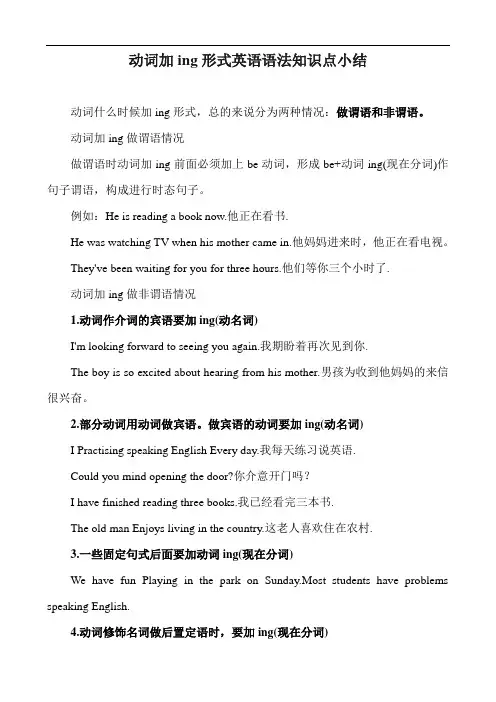
动词加ing形式英语语法知识点小结动词什么时候加ing形式,总的来说分为两种情况:做谓语和非谓语。
动词加ing做谓语情况做谓语时动词加ing前面必须加上be动词,形成be+动词ing(现在分词)作句子谓语,构成进行时态句子。
例如:He is reading a book now.他正在看书.He was watching TV when his mother came in.他妈妈进来时,他正在看电视。
They've been waiting for you for three hours.他们等你三个小时了.动词加ing做非谓语情况1.动词作介词的宾语要加ing(动名词)I'm looking forward to seeing you again.我期盼着再次见到你.The boy is so excited about hearing from his mother.男孩为收到他妈妈的来信很兴奋。
2.部分动词用动词做宾语。
做宾语的动词要加ing(动名词)I Practising speaking English Every day.我每天练习说英语.Could you mind opening the door?你介意开门吗?I have finished reading three books.我已经看完三本书.The old man Enjoys living in the country.这老人喜欢住在农村.3.一些固定句式后面要加动词ing(现在分词)We have fun Playing in the park on Sunday.Most students have problems speaking English.4.动词修饰名词做后置定语时,要加ing(现在分词)There is a boy Crying over there.I felt something moving in the house.I heard someone singing in the next room.5.动词做主语和表语时,动词要加ing(动名词)Swimming is very popular in summer.His job is teaching English.综上所述,动词在以上六种情况需要加ing!增强背诵记忆的方法• 勤动手指锻炼手指功能可健脑益智,促进思维。
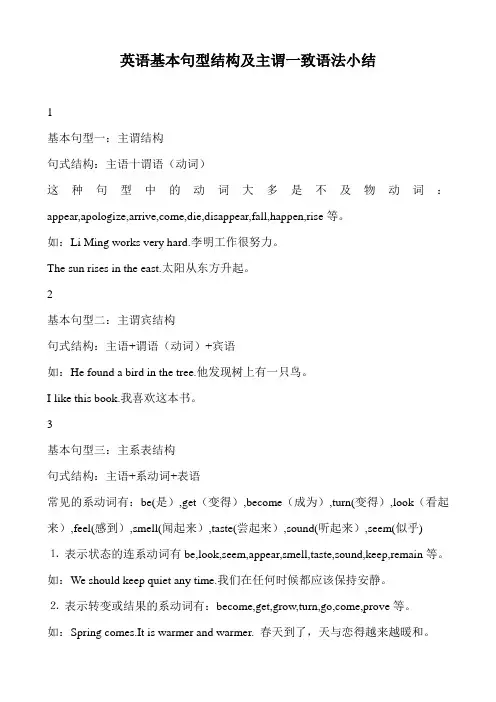
英语基本句型结构及主谓一致语法小结1基本句型一:主谓结构句式结构:主语十谓语(动词)这种句型中的动词大多是不及物动词:appear,apologize,arrive,come,die,disappear,fall,happen,rise等。
如:Li Ming works very hard.李明工作很努力。
The sun rises in the east.太阳从东方升起。
2基本句型二:主谓宾结构句式结构:主语+谓语(动词)+宾语如:He found a bird in the tree.他发现树上有一只鸟。
I like this book.我喜欢这本书。
3基本句型三:主系表结构句式结构:主语+系动词+表语常见的系动词有:be(是),get(变得),become(成为),turn(变得),look(看起来),feel(感到),smell(闻起来),taste(尝起来),sound(听起来),seem(似乎)⒈表示状态的连系动词有be,look,seem,appear,smell,taste,sound,keep,remain等。
如:We should keep quiet any time.我们在任何时候都应该保持安静。
⒉表示转变或结果的系动词有:become,get,grow,turn,go,come,prove等。
如:Spring comes.It is warmer and warmer. 春天到了,天与恋得越来越暖和。
4基本句型四句式结构:主语十谓语(动词)十间接宾语“人”十直接宾语“物”结构,但若要先说出直接宾语(事物),后说间接宾语(人),则要借助于介词to或for。
⒈用to侧重指动作的方向,表示朝着,向着,对着某人;间接宾语前需要加to 的常用动词有:bring,give,hand,lend,offer,pass,pay,read,sell,send,show,teach,tell wish,write等。
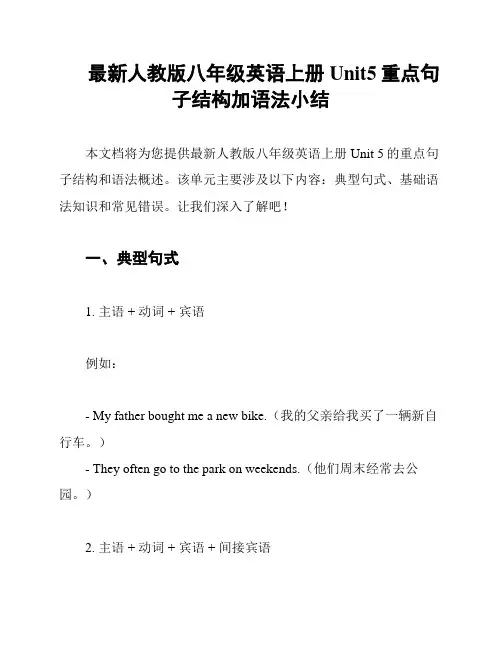
最新人教版八年级英语上册Unit5重点句子结构加语法小结本文档将为您提供最新人教版八年级英语上册Unit 5的重点句子结构和语法概述。
该单元主要涉及以下内容:典型句式、基础语法知识和常见错误。
让我们深入了解吧!一、典型句式1. 主语 + 动词 + 宾语例如:- My father bought me a new bike.(我的父亲给我买了一辆新自行车。
)- They often go to the park on weekends.(他们周末经常去公园。
)2. 主语 + 动词 + 宾语 + 间接宾语例如:- She gave her friend a birthday present.(她给她的朋友一份生日礼物。
)- The teacher showed the students a new way to solve the math problem.(老师给学生展示了一种解决数学问题的新方法。
)3. 主语 + 动词 + 宾语 + 宾语补足语例如:- We elected him class monitor.(我们选他当班长。
)4. 主语 + 系动词 + 表语例如:- She is a talented singer.(她是一位有才华的歌手。
)- The book seems interesting.(这本书看起来很有趣。
)二、基础语法知识1. 一般现在时一般现在时用于表达经常性、惯性的动作或现实情况。
例如:I go to school every day.(我每天上学。
)2. 一般过去时一般过去时用于过去某个时间发生的动作。
例如:She visited her grandparents last weekend.(她上个周末去看望她的祖父母。
)3. 现在进行时现在进行时用于表示现在进行中的动作。
例如:They are playing basketball in the park.(他们正在公园里打篮球。
高中英语语法小结一、句子结构英语句子主要由主语、谓语和宾语构成。
其中主语是句子的主要名词或代词,谓语是表示动作或状态的动词,宾语是动作的承受者或受益者。
二、时态英语语法中有很多时态,常见的包括:1. 现在时态:表示现在的动作或状态。
2. 过去时态:表示过去的动作或状态。
3. 将来时态:表示将来的动作或状态。
4. 现在进行时态:表示现在正在进行的动作。
5. 过去进行时态:表示过去某一时刻正在进行的动作。
三、名词名词是指人、物、地方、抽象概念等的名称。
根据用法和形式的不同,名词可以分为可数名词和不可数名词。
四、动词动词是指表示动作或状态的词语。
根据动词的形式和用法,动词可以分为一般动词、助动词和情态动词。
五、形容词和副词形容词用于修饰名词,描述事物的特征;副词用于修饰动词、形容词和其他副词,表示动作的方式、程度或频率。
六、代词代词用于替代名词,避免重复使用。
七、介词介词用于连接名词或代词与其他词语,表示位置、时间、原因等关系。
八、连词连词用于连接句子或词语,表示并列、转折、因果等关系。
九、句型和句式英语有多种句型和句式,常见的有陈述句、疑问句、祈使句和感叹句。
十、从句从句是一个完整的句子,可以充当另一个句子的一部分,通常作为主句、宾语从句、定语从句或状语从句使用。
十一、语态英语语态包括主动语态和被动语态,用于表示动作或状态的不同叙述方式。
十二、虚拟语气虚拟语气用于表示非现实或假设的情况,通常使用虚拟条件句和虚拟结果句。
以上是高中英语语法的简要小结,希望对你有帮助!。
如何学好英语语法小结英语语法一直被认为是学英语的难点之一,因为它有着繁杂的规则和诡异的用法。
但是,掌握好英语语法却是学好英语的基础,只有建立起稳固的语法基础,才能更好地理解英语,并能够准确地运用到实际生活中。
下面就分享几点如何学好英语语法的方法和技巧。
1. 掌握基本语法知识首先,要学好英语语法,就要掌握基本语法知识。
英语语法主要包括词类,句子结构和句法等三大要素。
要想学好英语语法,就需要充分了解这些基本概念,包括名词、代词、形容词、副词、冠词、动词、时态、语态、主谓宾等。
只有掌握了这些基本知识,才能更好地理解和应用英语语法。
2. 学会思维与语言的结合学习语法并不是机械地背诵规则,而是要将语法知识和实际运用相结合。
通过大量的阅读和听力训练,可以帮助我们更好地理解和运用英语语法。
在阅读过程中,不仅要注重语法知识,更要注重语法意识,通过思考句子结构和语法规则,从而提高对语法的感知和运用能力。
3. 刻苦练习熟能生巧。
只有通过不断的练习和反复的操练,才能夯实对英语语法的理解和运用。
可以通过做语法练习题,写作练习,口语练习等方式来巩固和提高对英语语法的掌握。
同时,要注重细节,关注常见的错误和问题,及时进行总结和纠正,有效提高自己的语法水平。
4. 多角度学习学习英语语法要多角度学习,不仅要通过书本和课堂学习,更要通过实际运用和交流来提高自己的语法水平。
可以通过参加英语角,参加外语培训班,与外国朋友交流等方式来提高对英语语法的学习和应用。
5. 自我总结学习英语语法要注重自我总结,及时总结学习的成果和经验,找出问题和不足,不断完善和改进自己的学习方法和技巧。
同时,要不断提高学习的兴趣和积极性,保持学习的动力和激情,愿意探寻和挑战更高更深的语法知识。
总的来说,学习英语语法并不是一件容易的事情,但只要认真学习,刻苦练习,不断总结,相信总有一天会掌握好英语语法,成为一个流利的英语使用者。
希望以上分享对大家有所帮助,祝愿大家学习愉快、进步顺利!。
初中英语小结——语法基础与单词积累英语是一门语言学科,语法与单词是其基础。
初中英语学习过程中,学习语法基础与单词积累至关重要。
本文将讨论这两个方面,以帮助初中英语学生提高学习成绩。
语法基础语法是英语学习的重点,因为正确的语法结构是交流的核心。
以下是英语语法的几个基本方面。
1. 时态:时态是表示动作发生的时间的概念。
英语有过去时、现在时和将来时三种时态。
在学习英语时,我们需要学习如何正确使用这些时态,以便在不同情况下正确地描述过去、现在和未来的动作。
2. 句型:一般情况下,英语句子都包括主语、谓语和宾语。
但是,还有其他类型的句子,例如疑问句、祈使句、感叹句等。
在学习句型时,我们需要了解每种句子结构的规则,例如主语和谓语一般要一致,句子的语序等等。
3. 语态:语态是指动词所表达的动作或状态对谁或何物发生的。
英语有主动语态和被动语态两种,需要学习这两种语态的不同,以便在不同情况下使用它们。
4. 比较级与最高级:这是描述事物之间关系的一种基本形式。
我们需要学习比较级和最高级的用法,以么应用它们。
单词积累除了学习语法,单词的积累也是很重要的。
以下是一些单词积累的技巧。
1. 词根:对许多单词进行分类可以找到使用相同根词的单词。
学习这些词根可以帮助我们更好地理解单词,并且可以提高词汇量。
2. 多种语汇:学习单词时,我们可以使用多种渠道。
例如,单词卡片、单词游戏、英汉词典、观看英语电影等等。
这些方法可以帮助我们记忆单词,并且可以使学习更加愉快。
3. 记忆技巧:有些单词可能较难记忆。
使用记忆技巧,例如创造联系或者句型记忆等等,可以帮助我们更好地记忆这些单词。
结论英语语法结构和单词的积累都是初中英语学生必须掌握的基础。
只有当我们深入了解语法结构并且积累了足够的单词时,才能有效地提高我们的英语能力。
希望本文对初中英语学生有所帮助。
英语知识要点巩固复习1.“too + 形容词或副词+to + 行为动词原型”——表示“太……而不能……”,注意该句型本身表示否定,不需要再加not.例如:The teacher speaks too fast to understand .2.距离的表达方式:(1)、表示某地离某地远,常用far from, 句式为:某地+be+far from+某地。
例如:Shanghai is far from our city. (2)、表示两地之间的具体距离,常用句式:It’s +数词+量词(kilometres/ metres)+from A 地+to B 地。
对句式中数词提问用how far. 例如:It’s 6 kilometres from my home to my school.How far is it from your home to your school?3、invite sb to do sth邀请某人干某事;invite sb tosp邀请某人去某地4、want to do sth =would like todo sth 想要干某事want sb to do sth=would likesb to do sth 想要某人干某事He wants me to come his home onSunday.5、taik to/with 和某人交谈、和某人谈话talk about sth 谈论某事He often talks about English withhis classmates.6、当hundred、thousand、million等前有具体的数字时,它们的词尾不能加S,当表示“数百个、数千个、数百万个“这种不具体的数字时,其后要加S和介词of 。
如:Our school has onethousand students./Our schoolhas thousands of students.我们学校有一千名学生/我们学校有数千名学生。
英语五大基本句型小结发表时间:2011-04-22T15:19:52.423Z 来源:《学英语》(初中教师版)2011年第36期供稿作者:赵小表[导读] listen为不及物动词,不可直接带宾语,加上介词to后, listen to 相当于一个及物动词,后面可带宾语。
河南洛阳市宜阳县张午乡一中赵小表句子是由主语、谓语、表语、宾语、宾语补足语等组成的,按其组合方式可分为五种基本句型,总结如下:1、主语S+谓语vi 此句型是由“主语+不及物动词”构成的主体部分,谓语动词为不及物动词,不可带宾语,但可以有状语修饰。
eg: (1) He runs in the park. 他在公园里跑步。
主语谓语状语 (2) Class begins. 开始上课。
主语谓语常见的不及物动词有:sleep, go, laugh, work, come, stay, swim, arrive, happy, take place 等。
2、主语S+谓语vt.+宾语O 此句型中谓语动词为及物动词,可带宾语,作宾语的有名词、代词、动名词、不定式等。
eg: (1) She likes English. (名词做宾语)他喜欢英语。
主语谓语宾语(2) I know him very well. (代词) 我很了解他。
(3) They want to go. (不定式) 他们想去。
(4) He stopped writing. (动名词) 他停下来不写了。
有些不及物动词在后面加上介词,相当于一个及物动词,后面可以跟宾语。
eg: You must listen to me. 你必须听我的。
listen为不及物动词,不可直接带宾语,加上介词to后, listen to 相当于一个及物动词,后面可带宾语。
3、主语S+系动词V+表语P 此句型中,表语部分是用来补充说明主语的,也叫主语补足语。
表示“……是……”、“……变成……”等意思,表语通常为名词、形容词。
(英语)英语句子结构与成分技巧小结及练习题含解析一、句子结构与成分1.The sentence structure of "They talked for an hour." is " ".A. S+V+OB. S+V+IO+DOC. S+V+A【答案】 C【解析】【分析】句意:句子"They talked for an hour."的结构是什么?A.主语+谓语+宾语;B.主语+谓语+间接宾语+直接宾语;C.主语+谓语+状语。
they是主语;talked是谓语;for an hour是状语,故选C。
【点评】考查句子结构,注意平时识记其分类。
2.Which of the following sentences is correct?A. He came in and sat down.B. We all like <Harry Potter>.C. When we met. He didn't say hello.D. We went out, headed for the bus stop.【答案】 A【解析】【分析】句意:下面那个句子是正确的。
A是简单句,came和sat是并列谓语,都是一般过去式,所以A正确。
B中的符号不符合英语习惯,在英语中没有书名号,表示书名时通常用斜体字形式。
C句的标点符号是错误的,把met后的句号改为逗号才符合复合句的定义。
D句中headed前应加上and或者将headed改为heading构成伴随状语。
因此选A。
【点评】考查句法知识。
3.John calls his dog Eddie. The structure of the sentence is _______.A. S+V+OB. S+V+PC. S+V+IO+DOD. S+V+DO+OC【答案】D【解析】【分析】句意:约翰叫他的狗Eddie.这个句子的结构是_____________.根据句子可知这个句子的结构是:主语+谓语+宾语+宾语补足语。